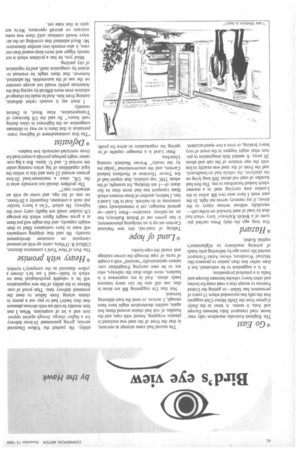Bird's eye view by the Hawk
Page 44

If you've noticed an error in this article please click here to report it so we can fix it.
*Go East
The England-Australia marathon rally may boost road transport links between Europe and Asia, it seems. A letter in the Daily Express from the Delhi Motor Club suggests that the rally has succeeded where 15 years of persuasion has failed—in getting the United Nations to accept that a road route for lorries and other heavy vehicles between Europe and India is a practical proposition.
It is a suggestion to be welcomed, but it does rather less than justice to pioneers like Michael Woodman, whose Asian Transport started life years ago by delivering attic-loads of printing machinery to Afghanistan's capital, Kabul.
*Hazard
Not long ago the daily Press carried pictures of a British Railways' lorry which had shot its load of steel forward on to.the cab— mercifully without serious injury to the driver, if my memory serves me right. In the past week I have seen two BR artics in the London area carrying steel in a manner which looked hazardous to me. The first had bundles of steel rod about 20ft long lying on the platform; the vehicle had no headboard, and the front of the steel was exactly in line with the rear window of the cab and about 2ft away. It needed little imagination to picture what might happen in the event of very heavy braking, or even a low-speed accident. The second had some attempt at restraint, in that the front of the steel was enclosed in plastics wrapping, bound with rope, and the bundles of rod had chains around them; but again, sudden deceleration might have been enough, I reckon, to send the load slithering forward.
Not that I'm suggesting BR are alone in this; one still sees far too many insecure loads about. And in my experience it is hauliers, more often than the railways, who are to be seen carrying Freightliner containers optimistically "secured" with a couple of turns of rope through the corner castings and round the rope-hooks.
*Land of hope
Talking of road-rail, this new National Carriers set-up is an intriguing phenomenon; it has grown out of British Railways, has an ex-railway executive—Peter Land—as general manager, yet is tremendously roadconscious in its outlook. And in Mr. Land it has, I believe, another of those winners which State transport has had more than its fair share of—I am thinking, for example, of the whole THC top echelon, that impish ball of fire Trevor Thornton at Northern Ireland Carriers, and the unconventional "judge me by the results" Werner Heubeck running Ulsterbus.
Peter Land is a manager capable of inspiring his organization to strive for profit
ability. He pushed the Yellow Diamond service, giving guaranteed 24-hour delivery for a higher charge, though against opposition and a lot of scepticism. When I met him recently he told me with obvious pleasure that they hadn't had to pay out a penny in claims arising from failure to meet the promised delivery time. That proof of confidence in the ability of the new organization will be a valuable psychological base on which to build—and I see he's chosen a yellow diamond as the company's symbol.
*Heavy with promise
The Port of New York's commerce director, Clifford B. O'Hara, came up with an unusual viewpoint on container development recently. He said that shipping companies will want to have containers filled to their weight capacity, and this might well put them at a gross weight figure which the average US trucker could not legally carry over the highway. He asked: "Can a heavy haulier put such a container, frequently a 20-footer, on one of his rigs, and come up with an attractive rate?"
The problem should not normally arise in the UK, since a maximum-load 20-foot grosses around 22 tons and this is within the legal capabilities of big artics running under the normal C. and U. limits. But a big container might perhaps provide a return load for those restricted-outwards low-loaders.
*Defeatist
"The first commandment of highway transportation is that there is no way to eliminate congestion on the highways in cities during rush hours." So said the US Secretary of Transportation, Alan Boyd, in Detroit recently.
I must say it sounds rather defeatist, coming from him. And he made his change or solution even more difficult by saying that the American public would not accept restraint on the use of the automobile. He admitted, however, that there might be eventual restraint by congestion itself, and by regulation of city parking.
Mind you, he has a problem which is not merely bigger and more deep-seated than our own, it also extends into another dimension: Mr. Boyd admitted that crowding on the airways would continue until there was some restraint on aircraft operators. We're not quite in that state yet.












































































































